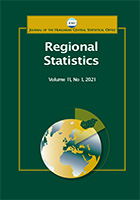Effectiveness of spatial justice in sustainable
development and classification of sustainability in Tehran province
Effectiveness of spatial justice in sustainable
development and classification of sustainability in Tehran province
Author(s): Kamran Jafarpour Ghalehteimouri, Ali Shamaei, Faizah Binti Che RosSubject(s): Social Sciences, Economy, Geography, Regional studies
Published by: Központi Statisztikai Hivatal
Keywords: spatial justice; sustainability; classification; Tehran; IDW
Summary/Abstract: This paper aimed to investigate the level of Tehran province sustainability in terms of environmental sustainability, current condition, and identifying effective environmental sustainability indicators within the province levels. The methods used in this research are descriptive-analytical for an effective assessment of non-quantifying issues. After that, the level of each province obtained through normalization of standard data in Excel software. Shanon Entropy evaluated the weight of each province and analyzed data in Arc GIS software mixed with Inverse Distance Weighted (IDW) model gave a clear understanding of spatial characteristics of each indicator and single sampleT-test used for spatial illustration ofthe IDW model on environmental sustainability. The results obtained from this research show that Tehran province is at the lowest level of sustainability among other provinces. The environmental sustainability in Tehran province with a mean of 157 is less than 165 standard deviation, and therefore the indicators of exploitation of varied natural sources of energy and water resources were known as the most important indicators.
Journal: Regional Statistics
- Issue Year: 11/2021
- Issue No: 02
- Page Range: 52-80
- Page Count: 29
- Language: English

